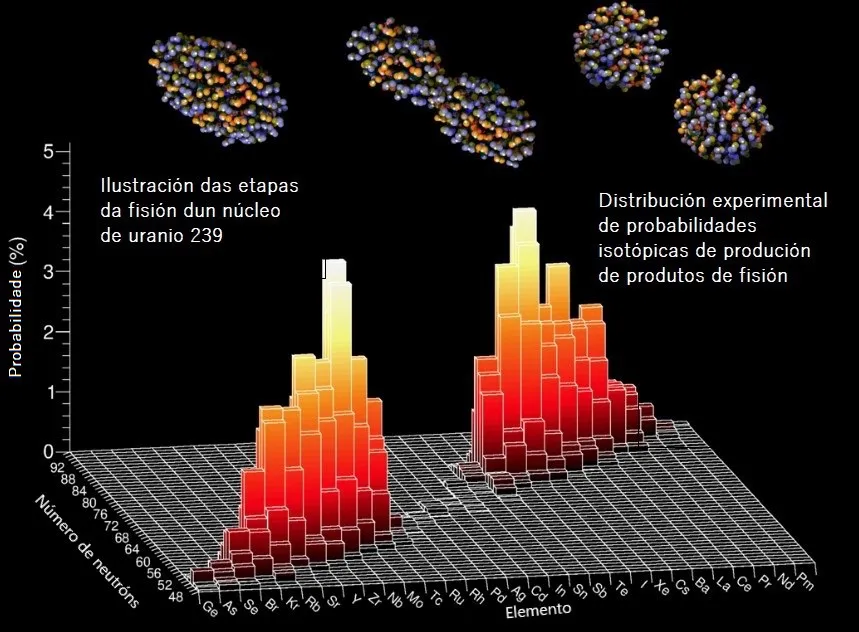Un experimento liderado polo investigador Manuel Caamaño do Instituto Galego de Física de Altas Enerxías (IGFAE), en colaboración cun equipo internacional en GANIL, mide e identifica con precisión os subproductos da fisión do uranio 239 usando unha técnica nova. Os resultados publícanse en Physical Review Letters.
A pesar de que hai 80 anos que se estuda o proceso de fisión nuclear, segue sendo relevante investigalo por dúas razóns principais: non entendemos do todo como funciona e aínda así é crucial para aplicacións en enerxía e industria. Por exemplo, na Península as centrais nucleares xeraron o 22,4% da enerxía eléctrica en 2017. Aínda que estamos lonxe do 72% de Francia, é a fonte primaria de enerxía en España, seguida da eólica cun 19,1%.
Un exemplo paradigmático dos procesos de fisión nuclear é do uranio 239, un isótopo con 92 protones e 147 neutróns que podemos fisionar se bombardeamos un isotopo de uranio 238 con neutróns. Cando un uranio 238 absorbe un neutrón, convértese nun núcleo de uranio 239 “quente”, con suficiente enerxía para fisionar. Ao dividirse en dous, os produtos desta reacción poden ser de centos de posibilidades diferentes, con probabilidades máis ou menos coñecidas. En experimentos anteriores mediuse a masa dos fragmentos emitidos, pero as limitacións nos sistemas de detección non permitían saber que elementos estaban a producirse e en que proporción. Neste punto, non había máis opción que confiar en modelos teóricos.
Con todo, en 2017 produciuse unha sorpresa dobre: un novo experimento foi capaz de medir indirectamente a proporción de elementos producidos na fisión de 239U e, ademais, os resultados mostraban unha enorme diferenza con respecto á teoría. En poucas palabras, críase que a estrutura do estaño 132 (132Sn) xogaba un papel importante na produción dos fragmentos, pero os novos datos non o corroboraban en absoluto e sementaban dúbidas ao basearse nunha detección indirecta.
Unha técnica nova
Aproveitando unha campaña experimental que se estaba desenvolvendo en GANIL (Gran Acelerador Nacional de Iones Pesados), en Francia, un equipo do IGFAE utilizou recentemente unha técnica nova que permite a medida directa e completa das propiedades dos fragmentos de fisión. Ao estudar unha reacción equivalente e comparar todos os observables posibles coa medida anterior, os resultados foron claros: a produción non mostra ningunha diferenza da esperada no efecto do 132Sn, en contra do referido no experimento anterior.
Os modelos teóricos, de momento, seguen no certo. De todos os xeitos, este experimento liderado polo investigador do IGFAE Manuel Caamaño non só estaba dedicado a comprobar esa anomalía. Agora, os datos están a ser analizados en Santiago por Daniel Fernández e Giorgia Mantovani, doctorandos do IGFAE, e en Francia por Diego Ramos, investigador postdoutoral en GANIL, egresado do IGFAE e primeiro autor deste traballo. No futuro, espérase que arroxen máis luz sobre o proceso de fisión a través de medidas directas para un número amplo de diferentes isótopos, aproveitando o dispositivo experimental único no mundo utilizado en GANIL.
Referencias:
[1] J. N. Wilson et al., Phys. Rev. Lett. 118, 222501 (2017)
[2] D. Ramos, M. Caamaño et al., Phys. Rev. Lett. 123, 092503 (2019)
Pé da imaxe: A figura mostra a proporción na que se produce cada isótopo na fisión de 239U. A forma en que se distribúe esa proporción é unha consecuencia da estrutura nuclear interna, é dicir, de como se ordenan os protones e neutróns dentro dos fragmentos que se forman no proceso. Crédito. GANIL.






